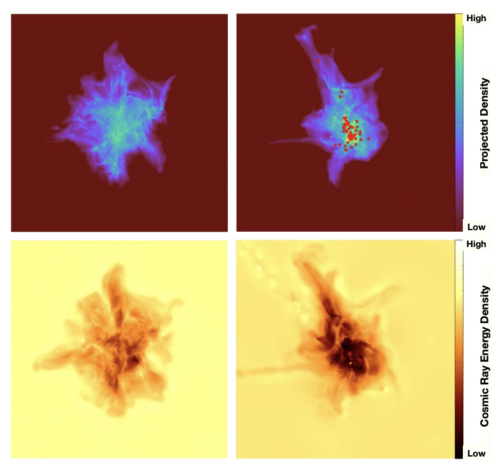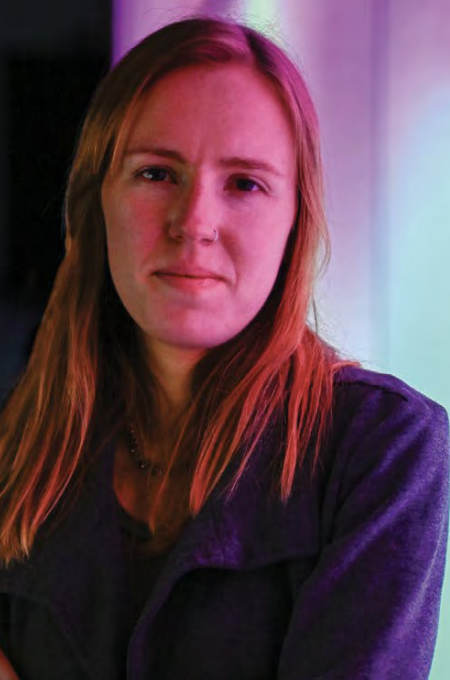Star treatment

Snapshots from a simulation chronicling the gravitational collapse of gases to form stars. A gas cloud’s density (top row) is seen against space’s relative low density (magenta background). After 1 million years (upper left), cloud turbulence more than 215 trillion kilometers in diameter has created filaments of various densities — from low (purple) to high (green). After 3 million years (upper right), the cloud has collapsed, and the densest areas (yellow) have formed stars (red). The energy density of cosmic rays interacts with the cloud gas and affects star formation (bottom row). Here, cosmic-ray energy density in the cloud decreases (darkens) from 1 million (lower left) to 3 million years (lower right). (Image: Margot Fitz Axen.)
Like many aspiring astronomers, a young Margot Fitz Axen grew even more fascinated by the field after reading Stephen Hawking’s A Brief History of Time. “Even in high school,” says Fitz Axen, now an astronomy Ph.D. candidate at the University of Texas at Austin, “I was interested in science, especially those space-science books about how the universe works, but I was mainly into programming.”
That interest took her to an undergraduate program at the University of Minnesota, where she planned to study computer science. Then, after a few courses in physics and working in the university’s Laser Interferometer Gravitational-Wave Observatory (LIGO) program, she switched to astronomy. The LIGO experience and a 2017 Department of Energy workshop on computational science at Los Alamos National Laboratory, Fitz Axen says, “really cemented my interest in astronomy.” Plus, it started an ongoing intrigue with national labs.
After earning her undergraduate degree, Fitz Axen returned to Los Alamos for a year writing computer codes and modeling the transport of cosmic rays in magnetic fields. Cosmic rays are high-energy particles that travel through space at nearly the speed of light.
She then moved to UT Austin to work with Stella Offner, an associate professor of astronomy, on how cosmic rays impact the birth of stars.
The two made a good fit, Offner says. “I’d been interested in cosmic rays for a few years and wanted to carry out more detailed modeling. Margot already had expertise in this area and is definitely very good at numerical methods and coding.”
In Fitz Axen’s first year there, she received a DOE Computational Science Graduate Fellowship (DOE CSGF). “I’d worked with people at Los Alamos, and they thought it would be a great opportunity,” she says. “It’s been a great experience, mainly financially, allowing me to really focus on my work and not worry about funding.”
What’s more, Fitz Axen’s fellowship expanded her perspective. Part of that comes from the program’s leadership. “They really want to make sure that you’re doing well in your research,” she says. And the fellowship led her to take classes outside astronomy. “I’m really into math and computational physics, so I took a couple applied-math classes and computer-science classes — parallel programming, machine learning and things like that.”
Besides expanding her skills, those classes fit Fitz Axen’s Ph.D. research on star formation simulations. She works on some of those simulations as part of the STARFORGE project, which is a collaboration of researchers across multiple universities who study star formation in gaseous environments. As Fitz Axen explains, “We start from the cloud of gas that the stars will form in, and we model the collapse of the clouds and the formation of each individual star.”
Beyond covering broad scales, these simulations take on the unknown, Offner says. “These are new problems.” Plus, astronomers lack information on some of the processes of star formation. That “makes it really important to check your work, apply physical reasoning and run tests to make sure that the result that you’re getting is correct. Margot is really good at that.”
As part of the DOE CSGF, Fitz Axen completed a practicum in a different branch of astrophysics with Peter Nugent, a senior scientist in the applied mathematics and computational research division at Lawrence Berkeley National Laboratory. There she worked on modeling the development of type 1a supernovae. “They originate from the explosion of an unstable carbon-oxygen white dwarf,” Fitz Axen notes. “Most of them have a very predictable brightness based on a mass of about one and a half times that of the sun.”
Some of these supernovae, however, are brighter than expected, or superluminous. By running hydrodynamic simulations of the supernovae explosions on the National Energy Research Scientific Computing Center’s Cori and Perlmutter supercomputers, Fitz Axen and Nugent concluded that the most likely explanation for superluminous supernovae was the merging of white dwarfs.
Meanwhile, Fitz Axen continued her Ph.D. research on the birth of stars. “We have many open questions about star formation,” she says. One of them is: What is the starformation efficiency? “If you have a cloud of gas, what percentage of it will be converted into stars?”
Although models of star formation already existed, they lacked an important piece of physics: cosmic rays. Fitz Axen is performing calculations that incorporate cosmic rays into the star-formation process, which she runs on the Stampede and Frontera supercomputers at the Texas Advanced Computing Center.
But making the simulations work, Fitz Axen says, is a complex task. “We really had to figure out how to accurately capture the physics and the effects of these charged particles without adding so much computational time that it would not be feasible. That was a long process.”
Fitz Axen says she fought her way through bugs in the code and other challenges, including the learning curve of running such large simulations. “A couple times, I did something wrong in the setup and had to go back and start again. I’ve done things like not backed up my data, lost it and had to restart.”
But her persistence paid off. She learned that an abundance of cosmic rays “has a pretty major effect on the star formation, because the outside pressure from the cosmic rays causes the clouds to collapse a bit faster, and actually formed more stars than simulations” with a typical Milky Waylevel of cosmic rays or no cosmic rays. Nonetheless, that result surprised Fitz Axen, who “expected that the cosmic rays would cause turbulence and actually create less star formation because it would disperse the gas cloud faster.” Instead, high cosmic-ray pressure increased star-formation efficiency by 3%–5%.
Offner described the finding and the work behind it as “huge and impressive.”
A couple projects remain between Fitz Axen and her doctoral degree. She plans to improve the cosmic-ray physics in her simulations and model how increasing the mass of gas clouds impacts star formation.
After that, Fitz Axen hopes to join a national lab, maybe Los Alamos or Oak Ridge, ideal places for someone with a computational-science background like hers, she says. “I think I could get the farthest in a place like that.”
Note: This article appears in the print version of the 2024 DEIXIS magazine.
About the Author
Mike May has worked as a full-time freelancer since 1998, covering topics ranging from biotech and drug discovery to information technology and optics. Before that, he worked for seven years as an associate editor at American Scientist. He earned an M.S. in biological engineering from the University of Connecticut and a Ph.D. in neurobiology and behavior from Cornell University.






You must be logged in to post a comment.